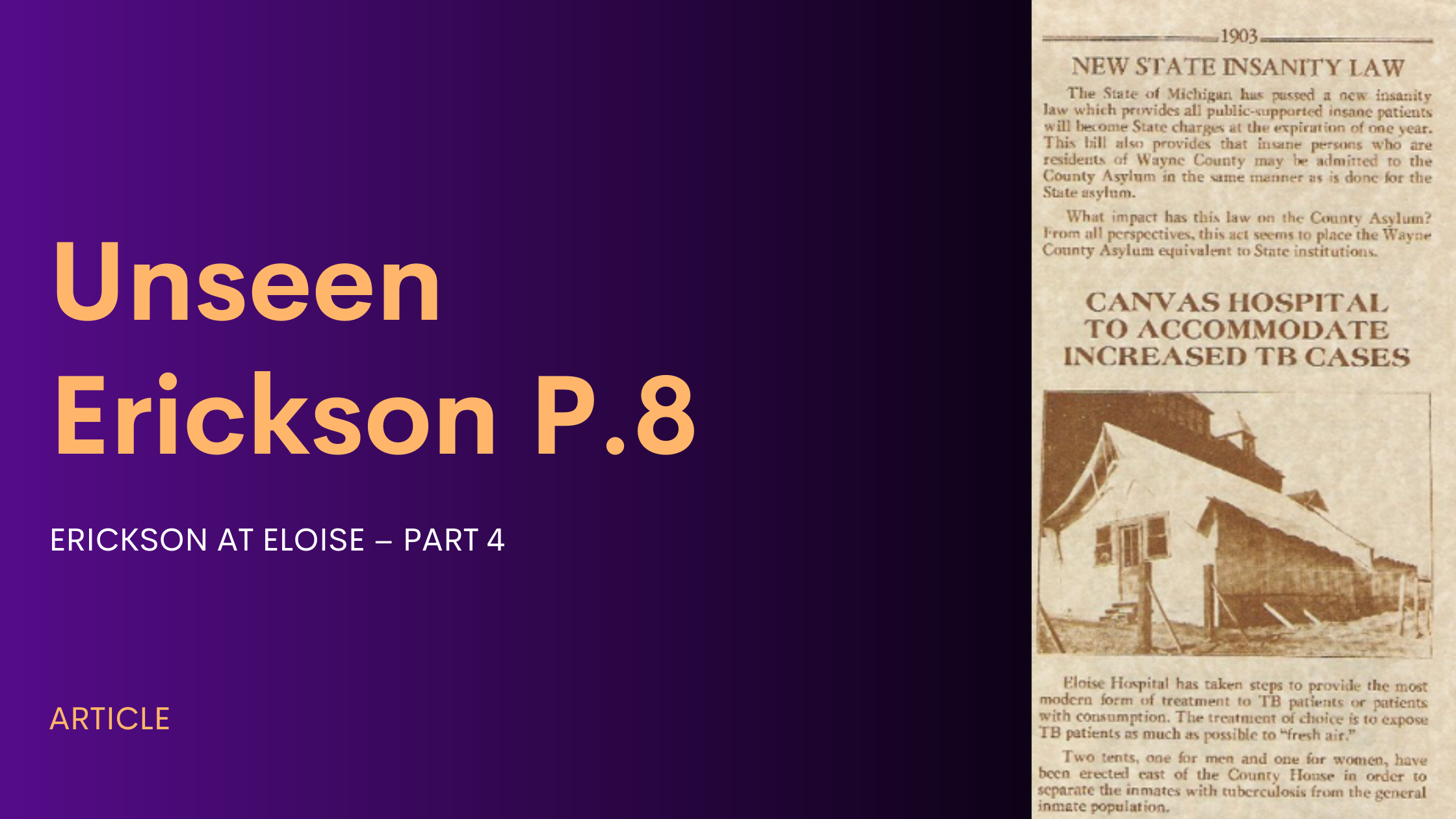Unseen Erickson P.8
FROM THE ARCHIVES OF THE ERICKSON FOUNDATION
Archives Location: R1-C4-S17
ERICKSON AT ELOISE – PART 4
YEARLY REPORTS FOR RESEARCH DEPARTMENT
by Joyce Bavlinka, m.ed., lisac
Sarah Clinebell, who has been working on the Erickson archives since June 2022, has supplied us with archival box S17 containing writings from the time Erickson was at Eloise. The archival box is part of the Milton H. Erickson papers, Medical and Clinical Books and contains five hard-covered 3-ring notebooks. The notebook is labeled on the spine, “Eloise Teaching and Research.” The notebook contains annual reports and outlines of hospital and research department responsibilities. The following papers are included in the notebook
Hospital Outline
Research Outline
Research Department: yearly report for an unspecified year
Department of Research Report 1937 – 8
Department of Research with a note at top: for Dr. Gruber
Department of Psychiatric Research and Training 1939
Clinical Director
Article regarding investigation into Dr. Gruber and purchasing costs dated: July 1942
According to “An Epic Life 2” by Jeffrey Zeig, Ph. D., Erickson served as director of psychiatric research and training at Eloise from 1934 to 1948. From 1938 to 1942, he also served as instructor, assistant and associate professor in the psychiatry department of Wayne University College of Medicine in Detroit, Michigan. From 1942 to1948, he was a full professor at the Graduate School.
While at Eloise, Erickson wrote clinical papers explaining some of his theory and experiences with hypnosis. He also conducted research. This blog post discusses the organization of the research department, the research conducted, his annual reports from 1936 to 1939, job descriptions for himself and for staff, and summaries of the number of clinicians working for him year-to-year. …..
HOSPITAL OUTLINE
This undated outline describes the hospital’s teaching program, affiliations with medical schools, teaching duties of staff, and research programs. The teaching program shows a rotation for 7 residents for 2 years of service, one year on the female wards and one year with male patients. Residents will be involved in the “examination and diagnosis of new patients, staff presentations, participation in clinics and rounds and special procedures. There was a focus on insulin, Metrazol, anti-luetic and special services.
The program will be affiliated with the Seymour Hospital, Wayne University and the University of Michigan. Time will be allotted for residents for regular attendance at the universities. Teaching duties for the residents will include teaching nurses, social workers, and attendants.
The research program will include studies on “insulin, Metrazol, picrotoxin, amytal, cobra venom, vitamin therapy, anti-luetic, curare, Dilantin and various other biochemical products.” There were other studies on occupational, recreational and music therapy.
RESEARCH DEPARTMENT
Another document in the notebook is a document detailing the work of the Research Department for an unspecified year. Laboratory studies included studies of blood grouping in cancer patients, toxicology studies of cancer serum, analysis of patient population in relation to early psychobiologic factors in the production of psychoses. Personal studies included the incidence of criminology among male psychiatric patients, obsessional and phobic behavior, and problems of insight, repression, and regression.
Projected studies included the role of Vitamin B in schizophrenia and an analysis of therapy for alcoholic patients. There was a listing of papers completed by Erickson and other hospital staff.
DEPARTMENT OF RESEARCH 1937 – 1938
The Department was established in May 1934 to:
“investigate various problems, the elucidation of which might serve directly or indirectly to better the care of patients and perhaps to contribute to a better understanding of medical and psychiatric matters.
During the last three years, the work of the department has been organized, projects initiated and completed, and a number of contributions have been made to the scientific literature.”
Psychiatric lab studies included the study of psychotic patients and a study of the blood groupings in schizophrenic patients and their relatives. Medical lab studies included the studies of blood groupings in cancer patients, methods for studying anaphylaxis and respiration, and the toxicology of cancer serum.
Some of the psychiatric studies included the “analysis of the patient population in relation to early psychobiotic factors in the production of psychoses, profiles of psychotic patients, the investigation of specific obsessional and phobic behaviors. Erickson published four articles including “Arrested Mental Development,” “The Experimental Demonstration of Unconscious Mentation by Automatic Writing,” “Psychological Factors Involved in the Placement of the Mental Patient on Visit and Family Care,” and “Development of Apparent Unconsciousness During Hypnotic Reliving of a Traumatic Experience.” He was in the process of writing 5 other articles.
The department reviewed current literature and secured reprints of articles for the hospital library. The department provided public lectures and training for residents and other hospital staff.
DEPARTMENT OF RESEARCH 1938-1939
Erickson and his team continued the work and research started the prior year. “the interest developed by various research workers in New York in some of the studies made by the research department had led to a collaboration between the head of research and Dr. Lawrence Kubie, Secretary of the American Psychological Association, in the carrying on of special research on the problems of ego organization and personality development.”
Erickson also provided public lectures and chaired a roundtable for the APA on the topic of techniques in hypnotic research, and trained and supervised two Yale graduate students who conducted research. Erickson published 8 articles and 8 more were in process.
DEPARTMENT OF PSYCHIATRIC RESEARCH AND TRAINING 1939 - 1940
During that period,
“the scope of the Research Department was enlarged to include the organization and supervision of clinical and didactic teaching in psychiatry, particularly for the residents in psychiatry. This was done as a measure of fulfilling all requirements of the American Medical Association for hospitals privileged to offer residencies in medical specialties. In addition to this new instructional work, the research work was continued as in previous years.”
Erickson was promoted from Clinical Instructor to Assistant Professor. His work included the instruction of residents in psychiatry, teaching at the medical school, providing special instruction to residents at the Seymour Hospital, providing lectures to graduate nurses at the hospital and seminars at the hospital, and a presentation to the American Psychiatric Association on dual personality.
Erickson’s articles were published in professional journals and an additional two papers with Dr. L. B. Kubie. Five other articles were accepted for publication.
THE CLINICAL DIRECTOR
Erickson prepared a 7-page paper describing the role of the Clinical Director, the advantages of a clinical directorship, the duties of a psychiatrist and the duties of the Out-Patient Service, the advantages of an out-patient service, the duties of the psychiatric medical service within the psychiatric hospital, and the advantages of a medical service within the mental hospital.
“The role of the clinical director is manifold in character. He is directly responsible for all departments of clinical work and is essentially the administrator, organizer, and correlator of the entire clinical work of the hospital.”
The Clinical Director is “responsible for the methods of treatment, promotes progressive work, particularly research.” Erickson cites advantages of a clinical directorship including the “centralization and organization of clinical work and systemization of all work pertaining to the care and treatment of the patients.” He also felt that a Clinical Director would expand opportunities for training and teaching.
Erickson details the duties of a psychiatrist including weekly notes, diagnostic summaries, participation in rounds, checking on the physical condition of patients, recommending lab investigations, organization and supervision of the wards, and serving as the Officer Of the Day [ OOD.] The OOD was responsible for admitting patients and assigning them to the proper ward, making preliminary exams and recording notes on the patient. The psychiatrist was also responsible for conducting visits to determine the patient’s suitability for discharge or home visits.
Erickson established the Out-Patient Service to identify patients who had significantly improved and were recommended for trial visits to family and returning to their homes. He saw the service offering the “opportunity for supervised discharge and continued psychotherapy.”
Although there was a hospital on the grounds of Eloise, Erickson advocated for the establishment of a medical hospital within the psychiatric facility. Erickson listed the following as advantages of Medical Service within the Mental Hospital.
“The betterment of the general hospital care of patients occasioned by:
a. Isolation of medical conditions serving to reduce the incidence of disease.
b. Concentration of medical conditions into a unit under a single hand, thereby permitting a systematic and more adequate handling of an important problem with closer and more expert attention to the individual patient.”
FOR DR. GRUBER - 7/20/39
Erickson prepares a three-page narrative for Dr. Gruber who is the Superintendent of Eloise. It outlines the three divisions at Eloise, the psychiatric hospital, indigent housing and the general hospital, in total serving 9,500 patients. The paper then discusses county and state funding and the organization of the hospital units.
“Of particular interest is the Eloise Parole Clinic, located in Detroit to supervise mental patients on parole from Eloise Hospital, the departments of Occupational and Recreational Therapy, the development of special drug treatment, particularly insulin and Metrazol, and the development and furtherance of all types of medical and psychiatric research as a measure of meeting and answering problems of mental and physical illness so important to the public.”
He also mentions the importance of “instruction on the problems of personal physical growth and development and the personal and social problems for boys ages of 15 and 18.” He ends the speech with “instruction upon the importance of the role of the individual in social problems and upon the interdependence of one individual upon another would contribute greatly to a feeling of individual security, which, in turn, would promote better mental hygiene.”
“ELOISE PHYSICIANS UPHOLD DR. GRUBER”
The notebook also contains the copy of a July 1942 article from the Detroit News entitled “Eloise Physicians Uphold Dr. Gruber,” by Martin S. Hayden. Gruber was superintendent of Eloise from May 1929 to August 1949.
The article indicates that Dr. Gruber, who became superintendent in 1929, was charged with inefficiency. Eloise started as a poor house and later became a mental hospital, a residence for indigents and the William J. Seymour hospital.
Five doctors who worked at the hospital came to his defense. One of the doctors commented, “Dr. Gruber is the man responsible for the transformation in the past decade old Eloise from a medical flop house to a hospital recognized throughout the country.” Another doctor recalled that prior to the appointment of Dr. Gruber as the head of the hospital,
“we used to take our own surgical instruments with us and boil them in a wash tub before operating. Prior to an operation we would arrange for other visiting doctors to assist us and then call in some ward attendants to act as a nurse. . . . No good medical student would consider Eloise for an internship. This year we have a full complement of interns and they are top graduates from the best medical schools in the country.”
In response to allegations of Dr. Gruber regarding excesses in purchasing, Dr. Weiser testified that:
“much of the evil in Eloise purchasing is not traceable to the hospital staff at all. Frequently, for example, we asked for 1,000 capsules and received 20,000. There were times when we asked for a specific number of bed sheets …. And were sent 10 times as many.”
He had “built a hospital from what was just an infirmary, …. Gotten one of the best scientific laboratories in the middle west, …. Built us hospital standards so that interns could be placed and set up a large clinical research department.”
Ultimately, the committee supported Dr. Gruber. In 1950, a new 500-seat auditorium was named for him.
Comments? Please run them by me.
Email: joyce@erickson-foundation.org







